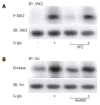Glycine-extended gastrin activates two independent tyrosine-kinases in upstream of p85/p110 phosphatidylinositol 3-kinase in human colonic tumour cells
- PMID: 16609991
- PMCID: PMC4087510
- DOI: 10.3748/wjg.v12.i12.1859
Glycine-extended gastrin activates two independent tyrosine-kinases in upstream of p85/p110 phosphatidylinositol 3-kinase in human colonic tumour cells
Abstract
Aim: To investigate whether Src, JAK2 and phosphatidylinositol 3-kinase (PI3K) pathways are involved in the proliferation of human colonic tumour cells induced by glycine-extended gastrin (G-gly), the precursor of the mature amidated gastrin and to elucidate the molecular interaction between these three kinases in response to this peptide.
Methods: Using the human colonic tumour cell line HCT116 as a model, we first measured the activation of PI3K, p60-Src and JAK2 in response to G-gly by in vitro kinase assays. Then we investigated the involvement of these kinases in G-gly-induced cell proliferation by MTT test.
Results: G-gly stimulation induced p60-Src, JAK2 and PI3K activation in HCT116. The different pathways were involved in proliferation of human colon cancer cells induced by G-gly. Furthermore, we found that both Src and JAK2 were necessary to PI3K regulation by this peptide. However, we did not find any cross-talk between the two tyrosine kinases.
Conclusion: Our results suggest that the p60-Src/PI3K and JAK2/PI3K pathways act independently to mediate G-gly proliferative effect on human colonic tumour cells.
Figures






References
-
- Seva C, Dickinson CJ, Yamada T. Growth-promoting effects of glycine-extended progastrin. Science. 1994;265:410–412. - PubMed
-
- Hollande F, Imdahl A, Mantamadiotis T, Ciccotosto GD, Shulkes A, Baldwin GS. Glycine-extended gastrin acts as an autocrine growth factor in a nontransformed colon cell line. Gastroenterology. 1997;113:1576–1588. - PubMed
-
- Singh P, Owlia A, Espeijo R, Dai B. Novel gastrin receptors mediate mitogenic effects of gastrin and processing intermediates of gastrin on Swiss 3T3 fibroblasts. Absence of detectable cholecystokinin (CCK)-A and CCK-B receptors. J Biol Chem. 1995;270:8429–8438. - PubMed
-
- Iwase K, Evers BM, Hellmich MR, Guo YS, Higashide S, Kim HJ, Townsend CM. Regulation of growth of human gastric cancer by gastrin and glycine-extended progastrin. Gastroenterology. 1997;113:782–790. - PubMed
Publication types
MeSH terms
Substances
LinkOut - more resources
Full Text Sources
Miscellaneous

